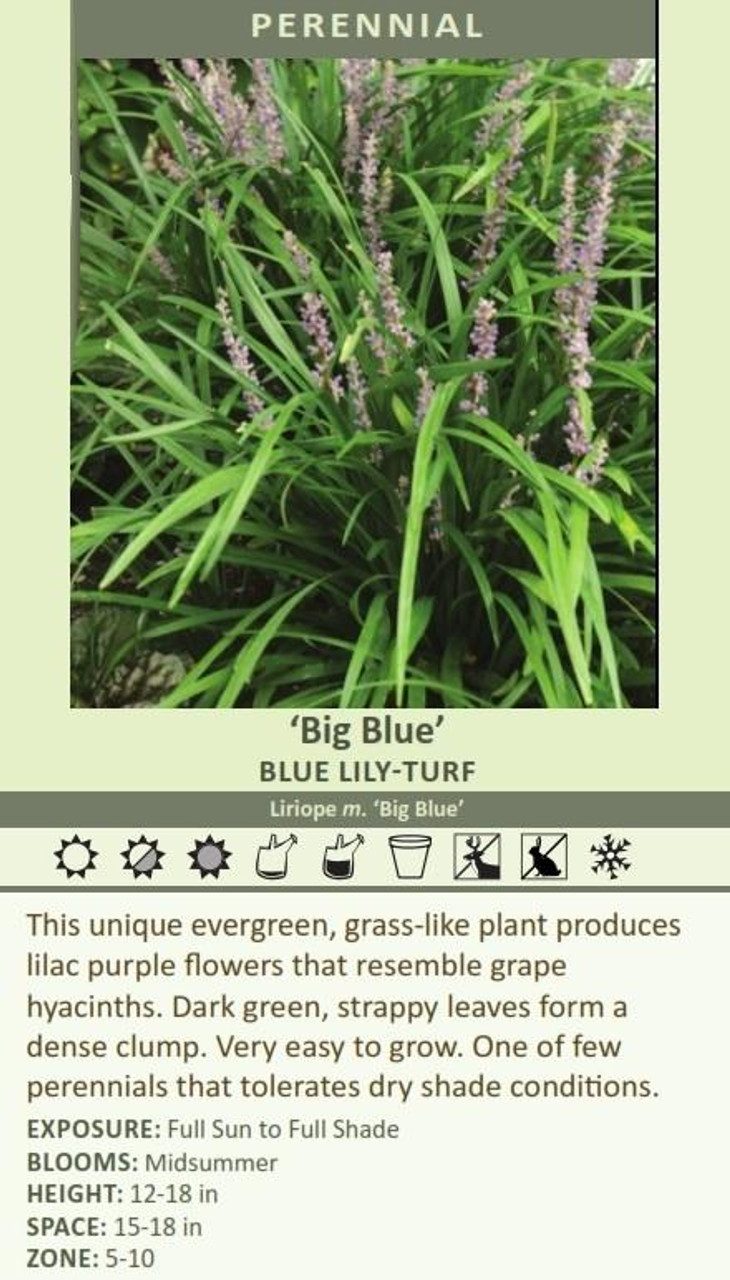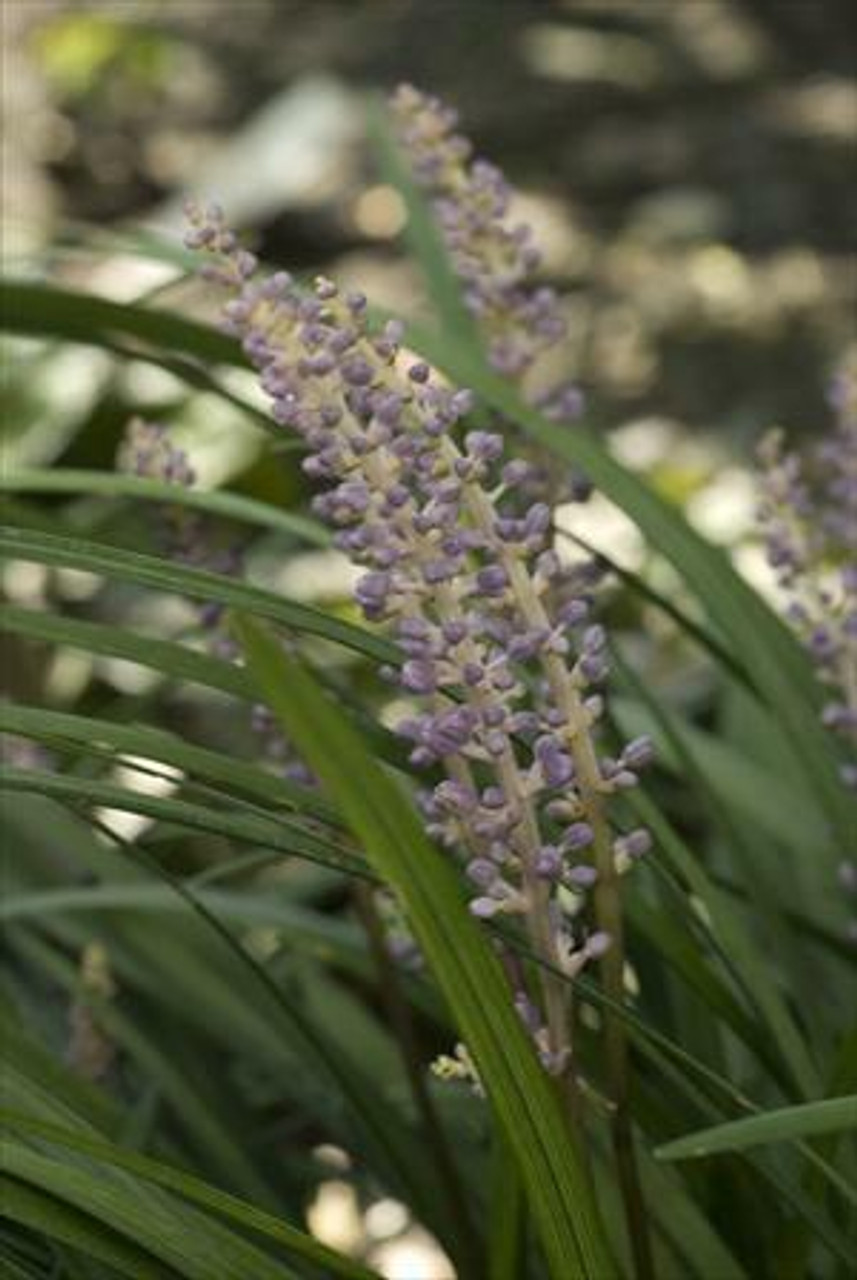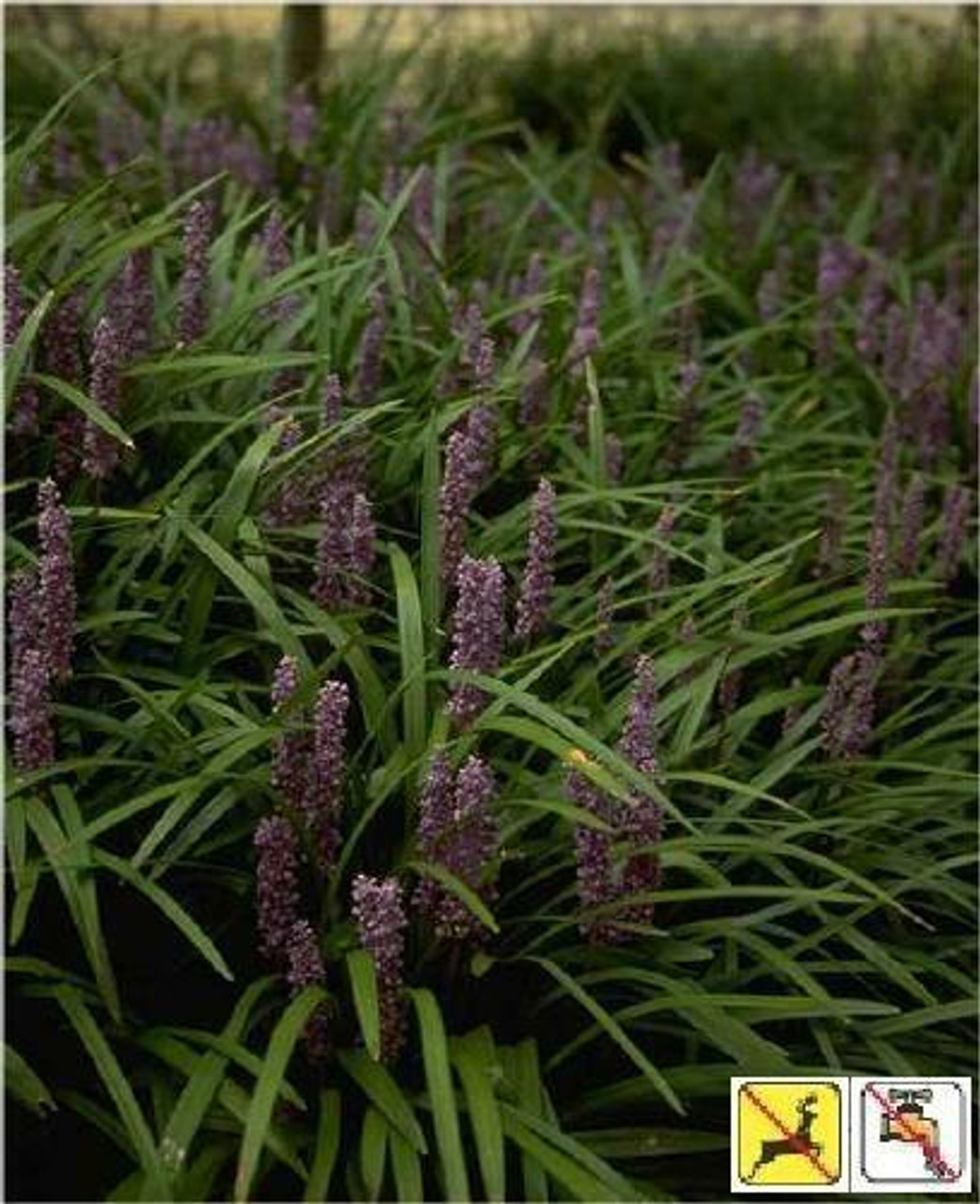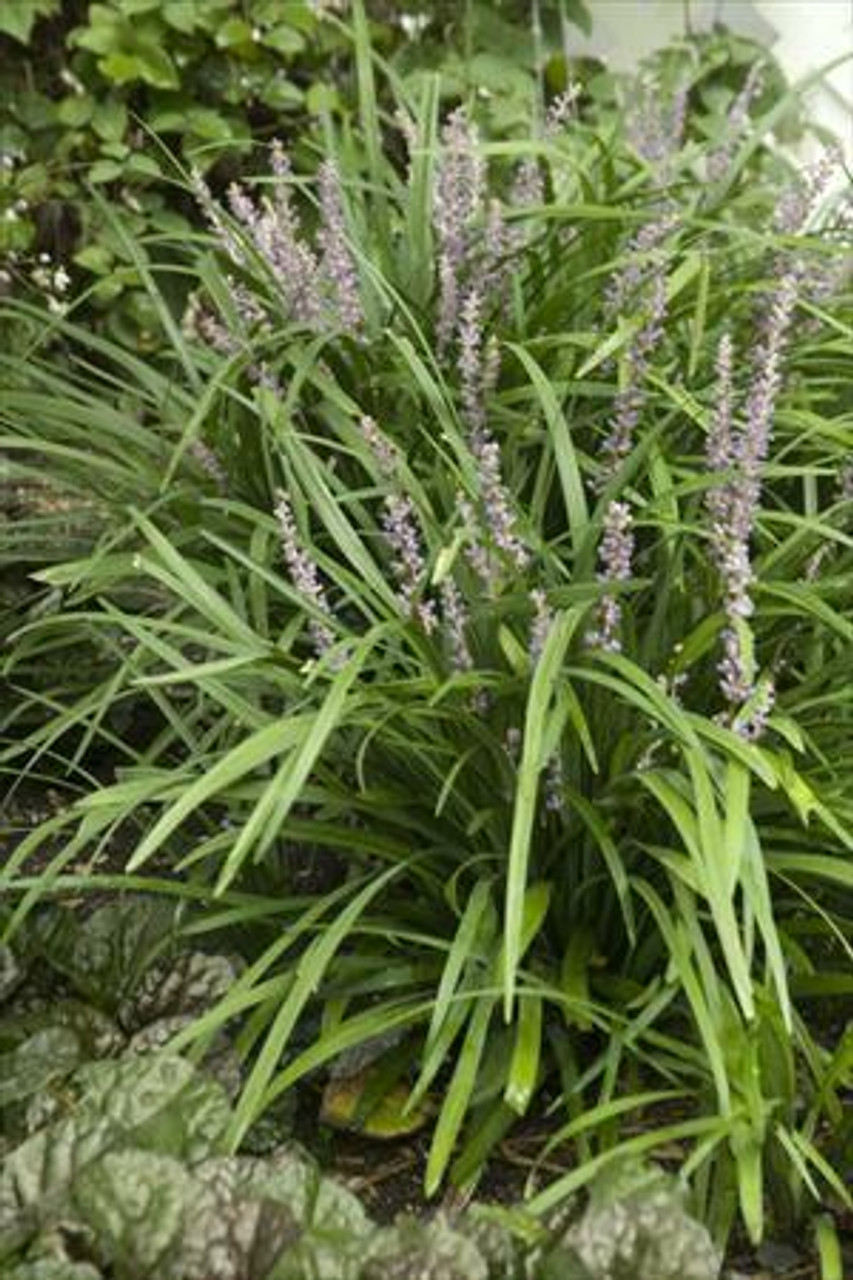Product Description
Liriope muscari 'Big Blue' Bare Root Plants
Common Name: Big Blue Lily Turf
Height: 12-15 Inches
Spread: 12-18 Inches
Hardiness Zone: 5/6-10
Sun to Shade
Evergreen - cut back late Winter
Lavender flower spikes - Mid-Summer followed by near black berries
Clumps expand by short rhizomes- more contained than spicata
Use for ground cover or controlled edging
Good choice for banks and slopes
Moderately salt tolerant
Liriope muscari 'Big Blue' is the standard of green Liriope. Big Blue has narrow, ¼" wide, green leaf blades. Blooms with lavender flower spikes mid-Summer and they are followed by near black berries. Big Blue Liriope clumps spread by short rhizomes. Perfect for erosion control on banks, slopes and large bed plantings. Can be used for borders and edging if kept in check. (See all other varieties of muscari that stay in clump form for use as borders or in mixed beds with less maintenance.)
Liriope grass, also called lilyturf, border grass, or monkey grass, looks a lot like a grass, but actually is a member of the asparagus family, Asparagaceae,
Liriope tolerates a wide range of soils and soil conditions, though it doesn't like constantly wet or boggy soil.
During the first growing season, water the plants regularly, at least 1 inch of water per week. Once established, liriope plants are relatively drought-tolerant.
Liriope can be mow during the late winter or early spring before new growth begins.
Use liriope as a groundcover, an edging plant to mark pathways or borders, naturalize under large trees, and in mass plantings for erosion control. A dense mat of liriope can stabilize soil on slopes and ditch banks. Liriope is a low-maintenance plant that is drought and deer-resistant.
Establish a lush, low-maintenance groundcover with Liriope muscari 'Big Blue' bare root plants! This popular lilyturf variety offers attractive, grass-like foliage and beautiful blue flower spikes, making it a versatile and adaptable addition to your landscape.
Description:
Liriope muscari 'Big Blue', commonly known as Big Blue Lilyturf, is a clump-forming perennial prized for its dark green, grass-like foliage and showy lavender-blue flower spikes that appear in late summer. It is a fantastic choice for groundcovers, borders, edging, and mass plantings. Bare root plants offer an economical and efficient way to establish a large planting of this beautiful and adaptable groundcover.
Details:
- Type: Herbaceous Perennial (Bare Root)
- Hardiness Zones: 5-10 (USDA)
- Mature Height: 12-18 inches
- Mature Spread: 12-24 inches
- Foliage: Grass-like, dark green, forms dense clumps
- Flowers: Lavender-blue flower spikes in late summer
- Berries: Black, berry-like fruits in fall
- Light: Full sun to partial shade (tolerates significant shade)
- Soil: Adaptable, prefers well-drained soil
- Water: Drought-tolerant once established
- Growth Habit: Clump-forming, spreading slowly
- Uses: Groundcover, borders, edging, mass plantings, container plantings
Planting and Care (Bare Root):
- Planting Time: Spring or fall is ideal for planting bare root Liriope.
- Preparation: Upon receiving your bare root plants, soak the roots in water for a few hours to rehydrate them before planting.
- Location: Choose a location with full sun to partial shade and well-drained soil.
- Planting: Dig a hole slightly larger than the root system. Create a small mound in the center of the hole and place the plant on the mound, spreading the roots outward. Ensure the crown (where the roots meet the stem) is level with the soil surface. Backfill the hole with soil, gently firming around the plant.
- Spacing: Space plants 12-18 inches apart for a dense groundcover.
- Watering: Water thoroughly after planting and keep the soil consistently moist (but not soggy) until the plants are established. Bare root plants require consistent moisture initially.
- Mulching: Apply a layer of mulch around the plants to retain moisture and suppress weeds.
- Fertilizing: A light application of balanced fertilizer after new growth emerges can be beneficial.
- Pruning: Cut back the foliage to 2-3 inches in late winter or early spring before new growth emerges.
Key Considerations:
- Bare Root Handling: Bare root plants require a bit more attention initially than potted plants to ensure successful establishment. Consistent watering is crucial.
- Spread: While 'Big Blue' Liriope spreads, it does so slowly compared to other Liriope varieties. It is less likely to become invasive.
- Versatility: Its adaptability to various light conditions makes it a great choice for both sunny and shady areas.
Create a beautiful and low-maintenance groundcover with Liriope muscari 'Big Blue' bare root plants! Order yours today and enjoy the lush foliage and lovely blooms for years to come.
Other Details
The most important part of the plant is its root system. Healthy roots are the foundation of a healthy, vibrant plant. The type of plug container used is based on the specific needs of the plants. Perennials offered as bare root traditionally perform better when planted as bare root.Planted in a specialized mix, potted plants have well established root systems. Top growth stage will vary depending on the current life cycle and time of year when shipped. In Winter and early Spring dormant plants may be shipped. Dormant plants may be planted right away, even before the last frost date.
Most bare root varieties are field grown for at least one season, though Hemerocallis and Hosta are grown for two seasons. The bulk of the soil is removed during the harvesting process and the tops of most varieties are trimmed back to the crown. They are graded, packed in shredded aspen or sphagnum moss and stored in freezers until ready to be shipped.
See our Container Sizes and Bare Root Perennials pages for more information.
Plant information and care is provided in the Overview section, Plant Genus Page and general information is provided in the Planting Care & Guides. Additional questions can be asked on each Plant page.
Plant Spacing: Using the maximum mature spread or width of a plant to guide spacing, ensures space to grow to full size. To fill an area sooner, plant them closer together. Just remember, future thinning or transplanting may be needed.
Water: Keep a close eye on newly planted perennials, especially throughout the first growing year. Most early plant loss is due to too much or too little water!
Product Videos
Custom Field
Product Reviews
2 Reviews Hide Reviews Show Reviews
-
Big Blue Liriope
The liriope was in excellent shape and remained viable until I could get them in the ground. You shipped more plants than I ordered, which was a good thing!
-
liriope
Very happy with quality and way they are taking hold.












